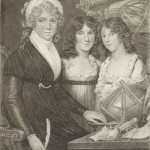By Lucy Inglis (Regular Contributor)
 It is a common misconception that during the Georgian period all girls were either not educated or were given a substantially different education than male children. This was, in some cases, true; but there were also tutors and academies all over the country, and particularly in London, which sought to give girls significant scientific and mathematical knowledge. Margaret Bryan’s schools are an excellent example.
It is a common misconception that during the Georgian period all girls were either not educated or were given a substantially different education than male children. This was, in some cases, true; but there were also tutors and academies all over the country, and particularly in London, which sought to give girls significant scientific and mathematical knowledge. Margaret Bryan’s schools are an excellent example.
Mrs Margaret Bryan was born, it is thought, some time before 1760. She had two daughters and was married to Mr. Bryan. In her thirties, she opened a school for girls near Hyde Park Corner. But Margaret Bryan’s school had one remarkable difference from its contemporaries: it was an academy for teaching girls mathematics and science.
In 1795, she moved the academy to Blackheath, where it flourished until 1806. In 1797 she published A Compendious System of Astronomy. In it, she excuses her temerity in writing on such subjects, explaining that the text was for the use of her students rather than for public consumption. Her friends, she said, insisted she publish, and she asked to be judged by those who like her, sought ‘truth, although enfeebled by female attire.’
Charles Hutton, Professor of Mathematics at the Royal Military Academy, Woolwich, endorsed the work of the ‘beautiful’ Mrs. Bryan, saying that, ‘even the learned and more difficult sciences are … beginning to be successfully cultivated by the extraordinary and elegant talents of the female writers of the present day.’ Hutton respected Bryan and encouraged her in her 1806 Lectures of Natural Philosophy: thirteen lectures on hydrostatics, optics, pneumatics and acoustics.
Her final publication came in 1815, with An Astronomical and Geographical Class Book for Schools. In 1816, she left for Margate, where instead of retiring, she opened another academy.
